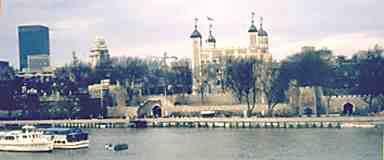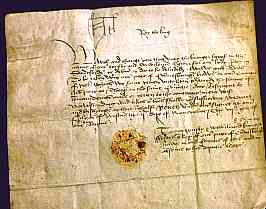

If you are looking at this page without frames, there is more information about medieval writing to be found by going to the home page (framed) or the site map (no frames).
| Dealing With Medieval Documents (2) | ||
| I have always had a huge admiration for scholars of yore who sat down and methodically catalogued and calendered immense quantities of documents so that others could do the interesting parts of the research on them. Nowadays this kind of work is referred to somehat sneeringly by some elevated members of the academic profession as mere antiquarianism. However, without the work of those patient and knowledgeable scholars, we would be seriously without tools for problem oriented, thesis based research. A calendar of a document collection is not merely a recording of dates, but a list with a brief summary of contents, including names and places. Very useful. These may be consulted in the archives where the documents reside, in better stocked national or academic libraries, and hopefully more often in scanned editions on the internet. | ||
 |
The Tower of London, where some of the English Public Records were once held. | |
| Not all medieval documents are held in major national collections. The National Archives in London, for example, basically holds documents and records that deal with relationships between the monarch and his subjects. This were stored in various places over the centuries, including the Tower of London shown above, sometimes in atrocious conditions. Survival of various classes of documents is fortuitous. During the course of the 20th century and beyond, large amounts of manuscript material in private hands has been accumulated in the various county archives. This particular source can be very hard to search, as over the centuries decontexted oddments have been preserved in family collections, some originally belonging to the family, others acquired out of antiquarian interest by some family ancestor. At the Reformation, material from monastic establishments found its way into private hands. Some has turned up in major libraries, such as the British Library, where the material tends to be catalogued by its acquisition rather than by any thematic process. In other words, anything could be anywhere. Archives of documents are held by the church in their archives and libraries, by ancient guilds, by town councils, by libraries and colleges of universities. Private families still hold medieval documents in their collections, and those are private property. Researchers can only have access to these if the owners are willing. | ||
 |
Chancery warrant of 1491 in which the king, Henry VII, orders Sir Thomas Fitzwilliam, keeper of the park at Connesburgh Hawe, to deliver 12 quick does for Bryan Sandeford, Squire of the Body, to stock his park at Thorp. (Nottinghamshire Archives DDFJ 10/9/3). By permission of Nottinghamshire Archives. | |
| When reading a document, it pays to have some knowledge what kind of document it is, how it fits into the process that produced it, and what is the standard format and wording. Taking an alphabet sample from a paleography book, or this website, and nutting it out letter by letter, can be a very slow process. Most legal documents are made up from standard elements and phraseology. Look at transcribed examples of various types of documents and pick up the standard tag lines: Sciant presentes et futuri; Noverint universi; Hec est finalis concordia; Notum sit; Sachent touz; Besecheth meekly; By the king (as above) .... Find the personal names, place names, date, witness lists. This will give you a set of letter forms that come from your specific document instead of from one vaguely like it reproduced in a book, and allow you to narrow down on the two lines or so that may tell you what the thing is actually about. | ||
| One document by itself probably will not tell much of a story. Interesting research has been done by looking through classes of documents for information which may have originally been peripheral to what the document was supposedly about. Lateral thinking produces new questions. I guess one of my favourite bits of research of this type is in Clanchy's From Memory to Written Record (Clanchy 1993) where he assesses the increased output of chancery documents over the 13th century not from the documents themselves, but by going to the Exchequer records and finding out how much sealing wax they bought. Think like Sherlock Holmes. | ||
|
|
||
|
If you are looking at this page without frames, there is more information about medieval writing to be found by going to the home page (framed) or the site map (no frames). |
||